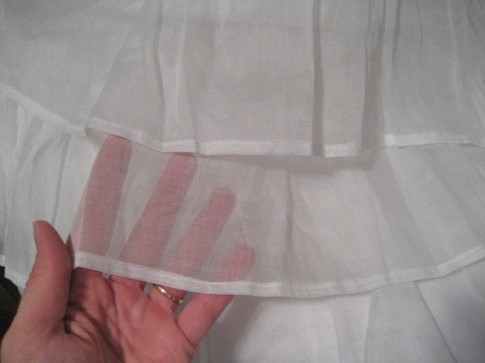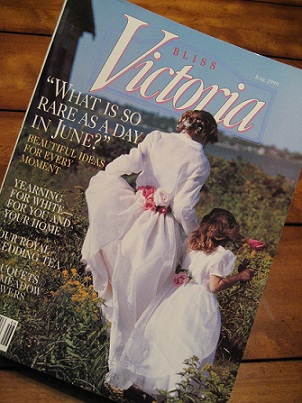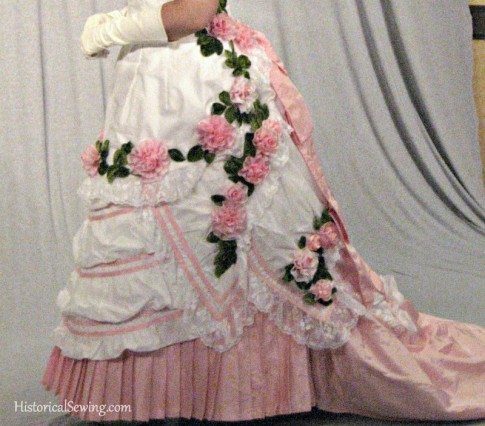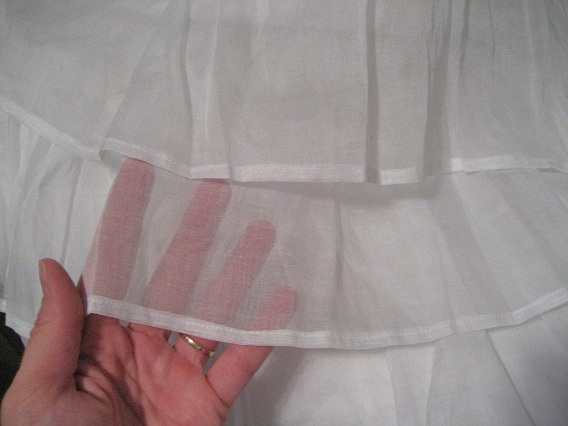
It was a distinct turning point in my historical costuming. I thought I was doing pretty good – my costumes were fairly accurate in style, my undergarments were all present, and my fabric selections did not include polyester or nylon. I soaked up all I could on how to make my Victorian clothing better.
What I didn’t expect was my introduction to a “standard” cotton textile that would ROCK my sewing world.
My friends… meet the Costumer’s Dream Fabric: Organdy.
The Backstory:
My long-time friend, lana/Lily, and I were researching corded petticoats and how starching is so important for an accurate 19th C. look.
Somehow she had recently thought of/found/researched and generally came up on cotton organdy. It was then we ran ahead in our minds and discovered all the glorious uses of this “basic” fabric.
The History:
Organdy is a plain-weave textile generally woven from cotton. It is then treated up to three different ways for either a permanent or semi-permanent finish. This finish is what gives it its stiffness. It’s a similar treatment as starching, and my guess is that today’s organdies are chemical finished.
In my mind, organdy was this unknown fabric that was only used in “old-fashioned” clothing (love that description) and not available anymore. (Have you thought that when hearing the word organdy?)
I still have a Victoria magazine from many, many years ago showing a woman in an organdy dress running through a tall grassy field and a little girl at her side. Her dress was a pure white organdy.

How could you make dresses from organdy? It was somehow embedded in my mind that organdy was stiff. A dress drapes. Organdy doesn’t. Well, that’s before I found out it comes in varying finishes: stiff and soft. (There is a medium finish available but not as quickly found in the marketplace).
The Difference:
Just to clear things up – organDY is made from cotton. OrganZA is traditionally silk but generally in polyester or nylon nowadays. (Avoid this stuff if you don’t want to swear out a storm.)
But you know what makes this the Dream Fabric?
- The weight is very light (HUGE feature)
- The ability to hold other fabrics together (like a base under trim or unusual fabric shapes)
- Holds its own shape (bias stretching is minimal)
- Being made of cotton
- The no need for starch
What You Can Make:
Being naturally stiff, use it for petticoats. 78% of them. Really. Especially the ruffles. You will ask yourself what took you so long to use this fabric.
Corded petticoats are beautiful and light-weight when made from organdy. (You don’t need a heavy fabric – the cords are weighty on their own and the stiff organdy will hold them in just fine.)
The thing about organdy is that it’s already starched so there’s a natural support built in. And it’s super lightweight to begin with (as if I haven’t mentioned it already). It’s a common modern misconception that you have to use a heavy fabric for petticoats. Why do that? Lightweight undergarments rock!

Use as an underlining for bodices and hem facings in skirts, or even fully flatlining a skirt. Collars & cuffs are natural uses. Belts, too, as an interlining.

Try it as a base for manipulated fabrics and applied trims like flowers and ribbons. Both aprons on my 1876 Wedding Cake Dress (above photo) and the 1873 Blackberry Cream Dress utilized organdy under the ruched fashion fabric to hold it in a defined shape.
Fast Sewing Tips:
-It can be slippery under your machine and you’ve got to control it. When you’re sewing a seam, the two edges can slip. Try a long hand baste stitch if you’re fighting with the organdy.
-Pins can slip out easily so pin accordingly.
-It wrinkles. Press as you would any cotton with a hot iron and steam. You may notice as you press the organdy gets soft. Not to worry – it stiffens as it cools.
-Press out all the creases before cutting your pieces. Use a rotary cutter and ruler for more precise cutting.
-Use a smaller needle like 70/10 to avoid large holes.
-Regular cotton/poly or poly thread works just fine.
-Keep to the grainline as you would on any other woven fabric.
Where to Buy Online:
Alas, I haven’t had good luck with finding organdy at the chains like JoAnn’s and Hobby Lobby. The large superstores might carry it for apparel but most of what you’ll find is in the home dec department. It’ll be called “organdy” but be 100% polyester or nylon. AVOID these!
You might also look in the interfacing section. (I know, weird, but it CAN be a great sew-in interfacing, not to be confused with crinoline.)
Pure Silks – A great place online for cotton organdy in both soft and stiff finishes. They are also on eBay as Exclusive Silks. Shipped from India it can take at least two weeks to receive in the US so plan ahead and order 10 yards at a time.
Needle & Thread (as Wooded Hamlet) – I’ve ordered many yards from here and being in the US can get to me quick. You’ll have to call to order & have it shipped. Be sure to ask how stiff their stock is as it varies. I’ve received both finishes from here.
Vogue Fabrics – One choice on the website: stiff, but it’s high quality.
Renaissance Fabrics – Diana has carried organdy in both 45″ and 60″ widths in the past. Inquire about stiffness and yardage in the inventory.
Farmhouse Fabrics – They have various organdies including COLORS. And if you want to go there, a quite expensive imported Swiss organdy – perfect for a little girl’s dress, not so much for a 10 yard-fabric bustle gown.
I encourage you to give organdy a try. You will love it!
Listen to my podcast episode 003 on organdy.
Have you used organdy before? Leave a comment below on what project you used it for.


Hello,
thanks for your blog and all the interesting tips regarding sewing. I would love to sew with organdy but being in mainland Europe, I haven’t found a supplier where I don’t need to pay tax/customs in addition to shipping, only vendors from US / UK / India.
The only site I have found is here: https://www.mqlt.de/Organdy-100-Baumwolle-fuer-Trapunto?n=1.2&r=2 – geared towards quilting, and the largest amount of fabric I am currently able to buy from them is 0.6m – that’s not enough for the petticoat of my dreams. Do you, or any of your lovely readers, have any recommendations for where to buy organdy in mainland Europe?
Thanks so much!
Does laundering remove the stiffening-finish form the organdy? I’d hate to go to all the toruble of using organdy to interline somthign only to find the stuffness washes out. I tend to hottest-machine-wash all my cottons before I used them so that all the potential for shirinking is out of the way before I make anything from it.
Yes, the stiffening can come out. It’s a type of glue that is coated on the fabric after weaving. Hot water will take it out faster than cold water. The higher quality organdies will retain stiffness longer.
Any ideas on how to soften up some new organdy? I love the feel of vintage organdy dresses but my new yardage is too stiff 🙂
Washing it for sure. It depends on how much stiffener is in the fibers. Perhaps a soak. Maybe with some baking soda.
Hey! If I want to use organdy to flat line an 1890s skirt (ripple skirt from TV, and I’m using some silk taffeta fabric), what weight of organdy do I want? I found the eBay seller you mentioned and they have soft, medium, and stiff.
Thanks!
I’d go with medium for the full skirt panels but definitely stiff for the hem facing.
Thank you!
Hello. I have some vintage placemats made with linen and organdy. After pressing they buckle. How do I iron so that they are flat?
Try using white vinegar. Spray on and press on high heat. You could also try a clapper or even heavy books to place on the hot fabric to keep the fibers flat as they cool. (More on using vinegar for pressing here.)
Hello, All. I a writing about my Mother’s wedding dress, which she created in 1943 from pale-blue-flocked-with-white organdy. It has retained its stiffness but has lain crumpled in a cedar chest for many years.
I would love to clean it but am afraid the flocking will fall off if I do. Over the phone, I was quoted $200.00 to $300.00 to have it cleaned and boxed. I am hoping that there is a less expensive solution in order to save this lovely creation. It is not huge and billowy but very trim and tailored with an A-line skirt attached to a shaped and fitted bodice. However, the sleeves are gathered at both the shoulders and the elbows. The sleeve fore-arm is fitted and ends in a point that covers the back of the hand.
Sounds like a beautiful dress!
You might test a swatch in a hidden area to see if water takes off the flocking. If it survives that, I recommend Retro Clean vintage textile laundry soap. But not sure about the flocking staying on. If you wash it yourself it will need lots of support and gentle handling while wet and lay flat to dry. Also, you might try to simply lay it out in the sun for 15-20 min at a time to freshen it up. Sunshine is a natural cleaner, but don’t leave it out too long.
I just stumbled across your blog and I already know it’s going to be SO helpful in my costuming journey! I am excited to start sewing petticoats and flat-lining skirts with cotton organdy, but before I do, I was wondering whether this fabric should be pre-washed. And if so, can it be dried in a dryer or should it be line-dried? I understand that, either way, it will need to be well ironed, but should I wash and dry it before even starting to work with it? Thanks so much for your advice!
Welcome to our Joyful Community, Lisa! So glad you’re here. 🙂
Being cotton, I highly recommend pre-washing organdy *IF* you intend to wash your final garment. I pre-wash probably 90% of cottons I use to release factory/shipping dirt and chemicals. However, if I’m using cotton organdy within or for a garment that I don’t intend to wash (perhaps dry clean) and merely spot clean, I’ll not machine wash but give it a good, hot steam press from the iron. Even a hot steam iron will help shrink the cotton fibers a little.
Best of luck and have fun sewing with organdy! I love this textile.
Thank you, this is very helpful! I will definitely wash my petticoats. It’s unlikely that I would wash a flat-lined wool skirt however, so this gives me great guidance for future projects!
You mentioned making a corded petticoat with organdy–I was wondering what you used as reference for the petticoat (book, pattern, picture, etc) as I would like to make one for myself and have been looking for inspiration!
I own three original corded petticoats that are made from cotton and/or linen. Many years ago a good costuming friend and I, as we were researching these petticoats, discussed using organdy as it’s a naturally stiff textile due to the sizing. BUT it’s also lightweight due to the open weave. And it’s a perfect selection for a corded petticoat! In my other research I have not found 19th century corded petticoats made from organdy (the semi-sheer textile); so I’m going to say it’s a more modern historical costuming method. Although, organdy type fabric was available the, it was more for collars and cuffs and chemisettes. And linen was still rather prevalent for petticoats. In my Workbook I have a chart comparing sizes and fabrics of nine original petticoats (including the three I own) and the fabrics range from very lightweight to heavy twill. Hope this helps!
Thanks for this article! I’m a historical costumer trying to get a grasp on getting the right silhouette and I’m thinking organdy petticoats might be the way to go!
Can you explain to me the difference between the regular cotton organdy and the Swiss organdy? Why the huge price difference? Is one better for certain projects than the other? Thanks!
The Swiss is more expensive because it’s one of the highest qualities of organdy in production. Italian organdy is very good too. “Regular” organdy is just fine for petticoats as they get washed more often and have more wear. The nicer, more expensive goods are for dresses and accessories.
Many years ago I went to Joannes and bought, probably, 15 yards of cotton organdy. I wanted fabric to make sheer inner curtains for my living room windows because I live in the city and the houses are close together. Since it’s a Victorian house, beautiful lace curtains would have been nice. But all I could find that I could afford were not natural fiber. I didn’t want cheap polyester lace sheers in my living room, plus I really wanted the curtains to give privacy. The saleswoman at my local Joanne’s (it has since closed, unfortunately, I have to drive a long way to get to one now) suggested organdy since it was lightweight (good for a sheer inner curtain) and opaque (for privacy).
Now, twenty years later, I am ready for a change in window dressing in my living room, and decided to make these long sheers into half window sheers, so I’ll get more sunlight in the living room but have the privacy of an opaque sheer covering the lower window. I’m taking out my stitching from the 7’ long sheers I made so I can wash the cloth, after which I’ll iron, cut it and sew new sheers, but to the lower half window size.
Do you have any suggestions for laundering the old cloth, and sewing the new curtains from the already used organdy? The organdy I have is not too stiff, but I guess it has some kind of treatment. I’m pretty sure it’s 100% cotton because it doesn’t have that funny smell (when you iron it) that cotton/poly blends have. Interestingly (and fortunately!) the cloth hasn’t had much yellowing, probably because the angle of the sun up here in the Northeast is usually at a pretty slanted angle (except for a month or two in the summer).
I loved reading your post and am so interested to learn about how organdy was traditionally used in the 19th century. Thanks for all the valuable information!
Hi! Thanks for your comment. I’m not versed in textile preservation so can’t give you experienced suggestions. Since the material isn’t all that old you might simply hand wash it in the bathtub with Oxyclean (only for use with modern textiles) or Orvis paste. See if that helps. You might just wet and wash a corner first to see if it doesn’t fall apart from the washing. Organdy has a surface treatment which is what makes it the textile that it is. If it’s high quality then the glazing finish won’t wash out.
Best of luck with the cleaning and new sewing!
Thanks! I soaked the panels in Oxyclean, then – gentle cycle in a couple of washing bags (for delicate stuff) – washed them. The yellowing came out, but when I ironed them I found a few panels with holes )-: . But since the sheers will only be half as long (1/2 window), I think I have enough cloth for the bay window (3 windows, but only one full size and two very narrow ones) and the other full size window. Thanks for your advice. btw, I love your wedding dress! That must have been so much work!!! Stay healthy, wash your hands, stay at home a lot and wear a mask when you have to go put shopping. . . Ciao, Bronwen
I stubbed on this article and it is very helpful for my current project. Does the organdy ned to be ironed after washing? I am looking for something easy-care for busy, working young mothers (my daughters!).
Yes. Organdy gets rather “crunchy” and wrinkled with washing. Laying flat to dry will help, but you’ll definitely want/need to press. In fact, after washing you might see it and wonder if all the wrinkle will press out, but don’t worry, they do! Organdy under a hot iron is magic. It softens up nicely and then as it cools it goes back to its natural stiffness.
Hi:
Can you please tell me where can I buy these organdy ruffles? Either in New York City or online. Thank you. Carole
Hi Carole,
I cut and sewed those ruffles myself for a petticoat. You can find organdy from the online vendors I list at the bottom of this post. I’ve not been to NYC, but in the garment district I’m sure you’ll find organdy or can ask one of the fabric shops who carries it locally for you in that area.
Hi,
Great post. Thanks very much for sharing.
In Colombo, Sri Lanka, where I grew up, the really well to do little girls were dressed in what was called a can-cans, in the ‘60s. I guess this is what you refer to as a petticoat. They also had petticoats which were more like under skirts, and also called under skirts.
The can-can had stiff piped tiers which held the dress out up and stiff. It was worn under the dress. Was of white organdy, or, I’m not sure if taffeta was also used. The tiers were piped in colours.
Thank you for this! I have definitely come in contact with the stiff variety before on some old items from my great aunts, and had no idea this is what it was called.
You’re welcome!
Hi my name is Billie Jean Queen. I love you site. I make hand made hand embordary vintage baby cloths. I have always loved to use lawn and organdy. I also like to use satan batices and silk dubeoney. I also English smock and make my own lace for trim on my baby things and pillow cases. I am glade I found this sit I like to learn from fellow sewers
Welcome to our Joyful Community, Billie Jean!